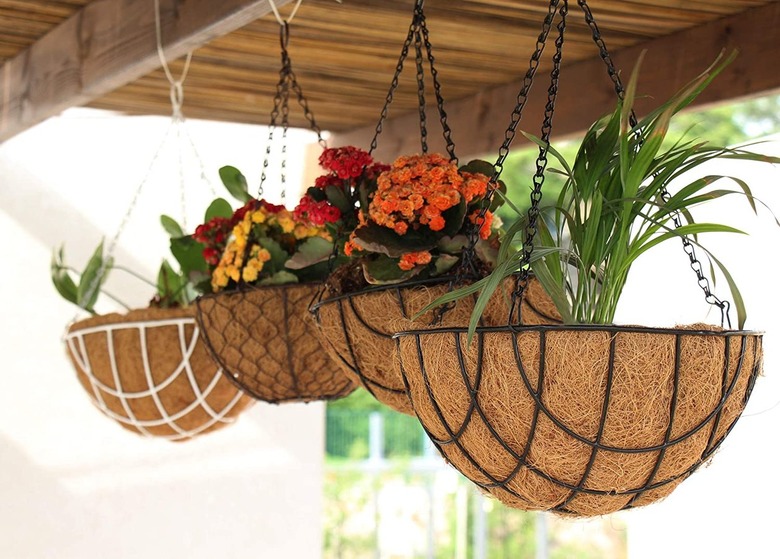How To Use Coco Liners
We may receive a commission on purchases made from links.
Coco liners, also known as coconut coir or coco coir, serve as a natural, safe material to use beneath the potting mixture in wire frame hanging baskets and planters. This brown, fibrous material allows excess water to drain out but keeps the soil and plants where they belong in the basket. Some coco liners are preformed to fit specific wire baskets or planters, but it's easy to cut and shape the material yourself. In some cases, coco liners also contain a bit of natural latex, while many are made only of coconut fibers.
Since both coco and moss liners allow lots of moisture to drain out, it may be harder to keep the potting mix moist than when using plastic hanging baskets. One option is to use a layered coco liner that has plastic between sheets of coir, or you can create the same effect yourself by placing a thin piece of plastic, such as a retail bag, between layers of coir after cutting drainage slits in the plastic.
Using Shaped Coco Liners
Using Shaped Coco Liners
Coco liners already formed to a specific shape pop right into the containers they're made for. Some have holes to insert plants through the sides so plants decorate the outside of the wire hanging basket as well, obscuring most of the coco liner. Gently press the liner into the wire basket form so it fits inside nicely without poking through the spaces between the wires.
If you intend to add some plants through the side holes of the basket, add some soilless potting medium up to the depth of the holes precut in the coir liner. If there are none, first use a clean craft knife to gently cut slits in the desired locations and then insert clean scissors to cut the slits into holes wide enough to insert the root end of the plants. Push each side plant through a hole in the side of the planter from the outside in so the root end winds up inside the planter and the foliage sticks out. Add whichever plants you'd like to go in the top of the planter and then fill the rest with soilless potting mix and water thoroughly.
For a planter without the side plants, add soilless potting medium, leaving indentations to add the plants. Gently loosen the roots of the plant, set it in the planter, and then arrange the potting mix around it. Water thoroughly.
Using Flat Coco Liner Sheets
Using Flat Coco Liner Sheets
Coco liner also comes in sheets or rolls, which are a great option if you'd like to use them in a group of baskets or for alternative purposes, such as lining a reptile or hamster cage. Cut the liner to the approximate shape of the basket or planter; a little extra is fine since it may be trimmed later. Gently press the liner into the planter and shape it to conform to the planter shape.
If it's difficult to shape the flat coco liner, soak the cut piece in a bucket of water for 30 to 60 minutes. This makes stiff liners more malleable and also provides a wet base for your potting medium. Press it back in place again, add the soilless potting mix, and then add your plants as you would with a preshaped coco liner. Water the potting mix thoroughly and then hang the basket as desired.
To use your coco liner for other purposes, such as pet pads or cage liners, be sure the product you've purchased is all natural and that it's designed for that use. Cut it to the desired size and insert it in the chosen location. Many coco liners are reusable and rinsable, so they're good for providing traction in the bottom of a reptile or small pet's cage. Any small scraps of coco liner left over are good to add as bedding in worm composting bins.
